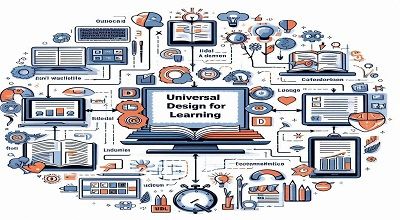Universal Design for Learning
Universal Design for Learning (UDL) is an educational framework and set of principles. That aims to make learning accessible to all students. Regardless of their individual learning differences, abilities, or disabilities. UDL is based on the idea that there is no one-size-fits-all approach to education. Instructional methods and materials should be designed in a way. That accommodates the diverse needs and preferences of learners.
UDL is often associated with the following three core principles:
- Multiple Means of Representation: This principle emphasizes the need to present information. And content in multiple ways to cater to diverse learners. This may involve using various formats, such as text, images, videos, and audio, to convey information. Providing alternative representations ensures that learners can access and understand the content in a way that suits their individual needs.
- Multiple Means of Engagement: UDL recognizes that learners have different interests and motivations. And preferences for how they engage with learning materials and activities. To address this, educators should offer multiple options for engaging with content and tasks. This could include incorporating choice, and varied instructional methods. Opportunities for learners to connect their personal interests to the learning objectives.
- Multiple Means of Expression: This principle focuses on allowing students to demonstrate their understanding and knowledge in different ways. Rather than relying solely on traditional assessments like written exams. UDL encourages educators to offer various means for students to express themselves. Such as through written assignments, oral presentations, multimedia projects, or interactive discussions.
The goal of UDL is to create inclusive learning environments that reduce barriers to learning and promote educational equity. By applying the principles of UDL, educators can better address the diverse needs of their students. And increase the likelihood of success for all learners. Regardless of their backgrounds or abilities. This approach can be particularly beneficial for students with disabilities. English language learners, and those who may have unique learning styles or preferences.
What is an example of a Universal Design?
An example of a universal design is a ramp. Ramps are architectural features that have been designed to be accessible to a wide range of people. Including those with mobility impairments, parents with strollers, and individuals carrying heavy bags or luggage. Here’s how a ramp represents universal design principles:
- Equitable Use: A ramp allows everyone, regardless of their physical abilities. To access a building or space in the same way. It doesn’t single out or create separate entrances for people with disabilities.
- Flexibility in Use: Ramps are not only used by people with wheelchairs. But also by individuals with walkers, canes, or other mobility aids. They are also convenient for people pushing strollers, carts, or bicycles.
- Simple and Intuitive: Ramps are typically straightforward to use. There are no complex instructions or specialized training needed to navigate them, making them intuitive for all users.
- Perceptible Information: Ramps are easily recognizable, often featuring sloped surfaces and handrails for added safety and guidance.
- Tolerance for Error: Using a ramp is forgiving; if someone doesn’t perfectly align themselves. While ascending or descending, it’s less likely to result in a fall compared to using stairs.
- Low Physical Effort: Ramps are designed to require less physical effort than stairs. Making them accessible to a broader range of people, including those with limited upper body strength.
- Size and Space for Approach and Use: Ramps are designed with adequate width. And turning space to accommodate various mobility devices and users with different needs.
- Aesthetic and Minimalist Design: Ramps are often integrated into the architectural design of a building in a way that is aesthetically pleasing. Rather than looking like an afterthought or an add-on.
Overall, a Ramp is an excellent example of a universal design. Because it provides a means of access that is inclusive and usable by a diverse range of individuals. Ensuring equitable access to a building or space for everyone.
